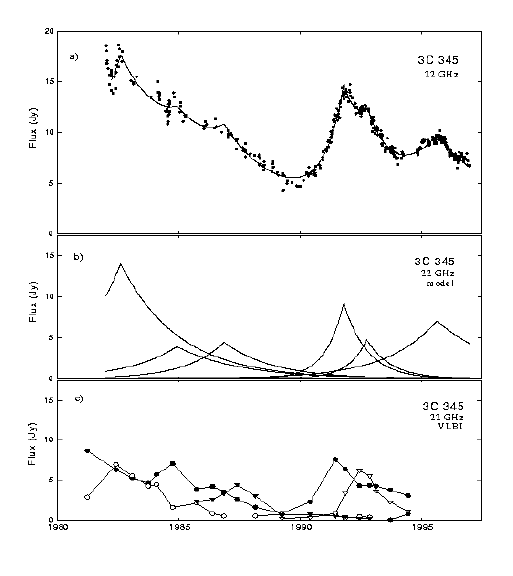We have started new observing and data analysis programmes for
the Planck project. Our source samples include objects that have
never been observed at these frequencies before, and the amount of
data analysed is unprecedented. At the moment our source list
includes approximately 700 sources. Not only are the observations
for the Pre-launch Catalog important in themselves, but we need to
know the behaviour and physics at work in these sources as well.
This knowledge is required both for the success of the CMB mapping
as well as for the non-CMB science.
The idea was to study new source populations and to get an estimate
of how they affect the Planck mission. In the past most of these
sources have been excluded from high frequency studies because they
are believed to be weak in the radio domain. However, our new
observations show that many (possibly hundreds) of these sources
are so bright in their active state that the Planck satellite can
easily detect them.
BL Lac Objects (BLOs)
We started to observe a large sample of BLOs in 2001 with the
Metsähovi telescope at 37 GHz. Most of the X-ray selected and
intermediate BLOs have never been observed at high radio
frequencies before, and we wanted to see whether this is justified
or not. By autumn 2003 we had covered 98 % of the sample (about 400
sources). Currently most of them have been observed several times
to look for variability. Of all these sources more than one third
were detected, and about one third of the X-ray and intermediate
BLOs, too, that have previously been thought to be too weak at
radio frequencies! The detection rate is higher than expected, and
some high-peaking BLOs seem to be well detectable also at lower
frequencies, at least in their active state. This automatically
means that these sources can also be detected by the Planck
satellite!
References:
Nieppola et al. "Spectral energy distributions of a large sample of
BL Lacertae objects", Astronomy & Astrophysics 445, 441 (2006)
Nieppola et al. "37 GHz observations of a large sample of BL
Lacertae objects", Astronomy & Astroophysics, submitted (2006)
Gigahertz-peaked spectrum (GPS) sources
We have been observing new samples of GPS sources with the
Metsähovi telescope at 37 GHz since November 2001, and with the
SEST at 90 GHz. The purpose is to search for new high-peaked
sources, to study the variability of the bona fide GPS sources and
the models used for describing them, and to study the impact of our
findings on the Planck mission. Our group has identified several
new extreme peaking GPS sources. It seems that the number of the
sources with inverted spectra, and thus being bright in the mm
wavelength domain, (previously excluded from high frequency
studies) is larger that earlier assumed. We have also shown that
many sources currently identified as bona fide GPS sources and
candidates in the literature actually are ordinary flat spectrum
sources with high variability that have inverted spectra only
during flares.
Our current working hypothesis is that the number of genuine GPS
sources is smaller than the estimates given in the literature.
However, the number of sources that sometimes, i.e. in their active
state, peak at high radio frequencies seems to be higher than
earlier assumed. This result is also of great importance for the
Planck mission, because these sources can at times be extremely
bright at the Planck frequency range. This emphasizes the
importance of the prediction of source activity states during the
mission, as well as the role of the radio flare modelling.
References:
Tornikoski et al. "Radio Spectra and Variability of
Gigahertz-Peaked Spectrum Radio Sources and Candidates",
Astronomical Journal 121, 1306 (2001)
Torniainen et al. "Long term variability of gigahertz-peaked
spectrum sources and candidates", Astronomy & Astrophysics 435, 839
(2005)
Variability analysis
One of the tasks in both defining the parameters for our Quick
Detection System as well as in planning multifrequency active
galactic nuclei observing campaigns during the Planck mission is to
study the long term millimetre variability of a large sample of
sources, and so better understand their variability and variability
timescale behaviour.

Click figure to view a larger version |
The figure on the left shows the flux curve of 3C345
decomposed into individual exponential curves (two upper
panels) and compared with VLBI data (lower panel). Using
this method, we have studied the typical variability
timescales and radio jet parameters of AGNs at 22 and 37
GHz. Currently we are studying a complete set of
high-frequency radio data at 90 and 230 GHz of ca. 150
sources. |
As a special interest for the Planck project, we are also looking
at the possibility of predicting activity in a source based either
on statistics or observed flux behaviour of the source.
References:
Valtaoja et al. "Total flux density variations in extragalactic
radio sources. I. Decomposition of variations into exponential
flares", Astrophysical Journal Supplement 120, 95 (1999)
Lähteenmäki et al. "Total flux density variations in extragalactic
radio sources. II. Determining the limiting brightness temperature
for synchrotron sources", Astrophysical Journal 511, 112 (1999)
Lähteenmäki & Valtaoja "Total flux density variations in
extragalactic radio sources. III. Doppler boosting factors, Lorentz
factors and viewing angles for active galactic nuclei",
Astrophysical Journal 521, 493 (1999)
WMAP unidentified and multiple identification sources
In cooperation with the Extragalactic Working Group we have
observed the unidentified and multiple identification WMAP point
sources immediately after the release of the WMAP catalog. We were
able to identify several of them. The WMAP data are also an
interesting guideline in the planning of the Planck mission.
|

